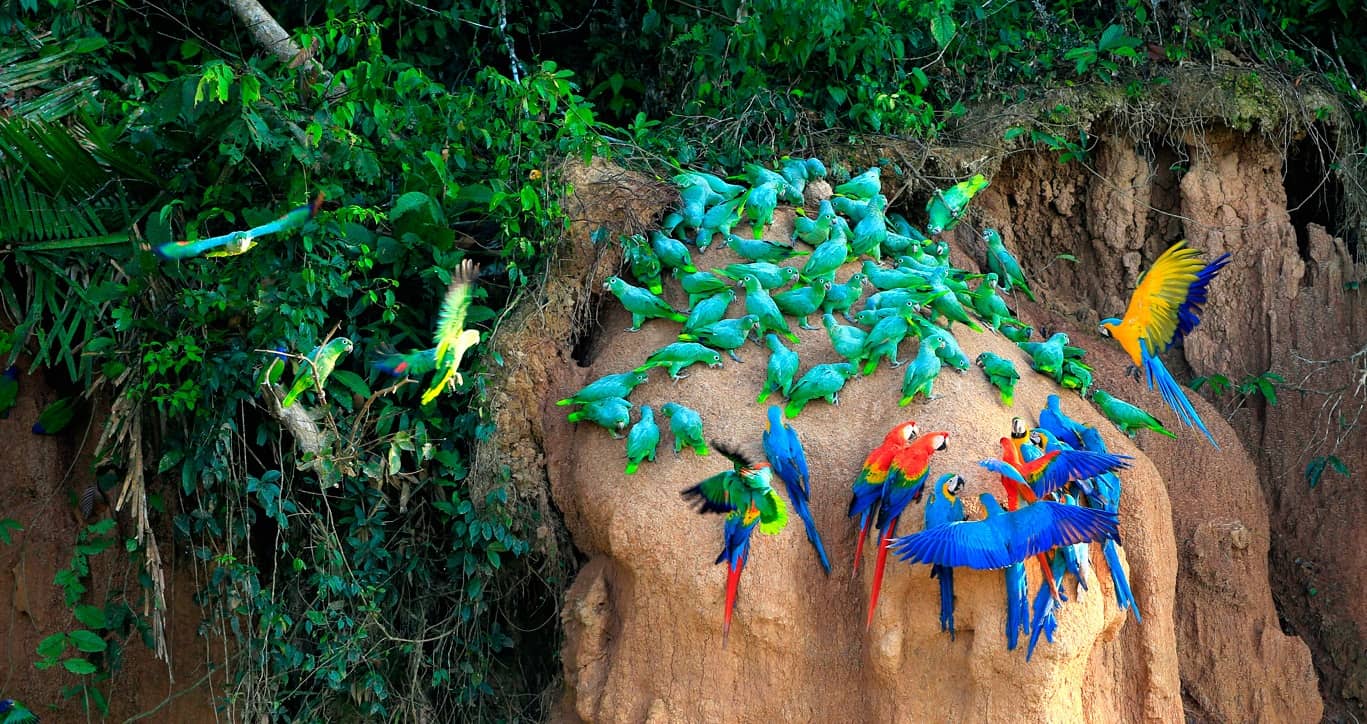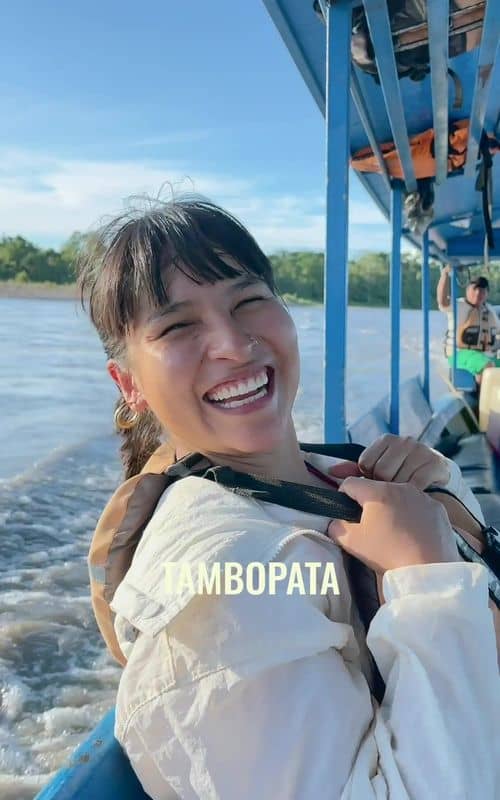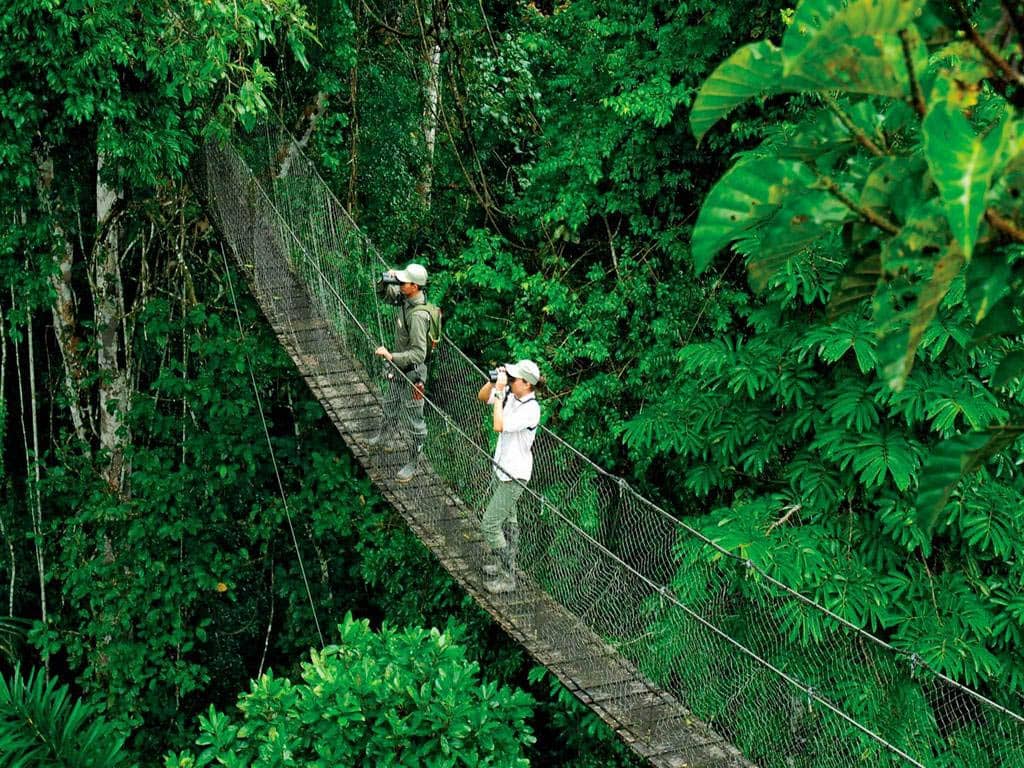Tambopata National Reserve Peru
Explore Peru's Amazonian heart in Tambopata National Reserve, a biodiversity hotspot teeming with wildlife and lush rainforest.

Highlights
Must-see attractions

Social
From TikTok & Reddit
Best Time
Fewer mosquitoes, easier trails.
Tambopata National Reserve Peru
Best Time
Fewer mosquitoes, easier trails.

Highlights
Must-see attractions
Explore Peru's Amazonian heart in Tambopata National Reserve, a biodiversity hotspot teeming with wildlife and lush rainforest.
"Truly an amazing place and experience. From observing the wildlife to basking in breathtaking sunsets, there's plenty of good memories to be made. "
Pack Extra Snacks
While meals are provided, they can be basic. Bring your favorite snacks for extra energy and variety. :snack:
Embrace Early Mornings
The best wildlife sightings often happen at dawn. Wake up early for tours to maximize your chances! :sunrise:
Highlights
Discover the most iconic attractions and experiences
Lago Sandoval
Oxbow lake within the reserve
Glide across serene waters, spotting giant river otters, caimans, and diverse birdlife. A true Amazonian gem.

Chuncho Macaw Clay Lick
Clay lick within the reserve
Witness hundreds of colorful macaws gather at dawn to eat mineral-rich clay. A spectacular natural phenomenon.

Canopy Walkways
Various lodges and tour operators
Experience the rainforest from a bird's-eye view, walking among the treetops. Incredible for spotting arboreal wildlife.
Plans like a pro.
Thinks like you
Planning Your Visit
Embrace the Amazonian Pace
Pack Smart for the Tropics
Best Times
Insider Tips
from TikTok, Instagram & Reddit
Pack Extra Snacks
While meals are provided, they can be basic. Bring your favorite snacks for extra energy and variety. :snack:
Embrace Early Mornings
The best wildlife sightings often happen at dawn. Wake up early for tours to maximize your chances! :sunrise:
Stay Hydrated
The jungle heat and humidity are intense. Carry plenty of water and drink it regularly. :droplet:
Bug Spray is a Must
Mosquitoes and other insects are prevalent. Use a strong repellent, especially during dawn and dusk. :bug:
Tips
from all over the internet
Pack Extra Snacks
While meals are provided, they can be basic. Bring your favorite snacks for extra energy and variety. :snack:
Embrace Early Mornings
The best wildlife sightings often happen at dawn. Wake up early for tours to maximize your chances! :sunrise:
Stay Hydrated
The jungle heat and humidity are intense. Carry plenty of water and drink it regularly. :droplet:
Bug Spray is a Must
Mosquitoes and other insects are prevalent. Use a strong repellent, especially during dawn and dusk. :bug:
Consider a Night Walk
Discover a different side of the jungle after dark, with unique nocturnal creatures. :flashlight:
What Travellers Say
Reviews Summary
Visitors rave about the incredible biodiversity and unique wildlife encounters in Tambopata, from macaws at clay licks to caimans on river cruises. The immersive jungle experience and the opportunity to connect with nature are consistently praised. However, some guests found rooms to be hot and lacking ventilation, and noted extra fees for certain park areas.
"My partner and I did a two-night, three-day tour, and it was really good. First, they picked us up from the bus station at 6:30 AM, which was amazing.
We are both vegan, and the food was surprisingly good, although breakfast was less so—only chips, avocado, and a small banana cake slice. Dinners were good, considering we were in the jungle. A lovely beans/veggies/rice dish/soya protein/lentils/ etc, make sure to bring snacks, as I'm extremely glad we did.
The tour itself was great. We were lucky enough to see a few caimans, capybaras, a sloth, a few tortoises, and some monkeys.
The only downside was the room lacked a fan or ventilation, making it extremely hot and difficult to sleep. Also, there was an extra 50 soles fee to visit the park next to the lodge, which, in my opinion, wasn't worth it and should have been included. I wish I had opted out of that.
But for the price of the tour (160 USD, not including the park fee), it was great.
We would recommend it to fellow backpackers."
Toby Adams
"Rule 1 of the Jungle: Bring insect repellent.
Truly an amazing place and experience. From observing the wildlife (both flora and fauna) to basking in breathtaking sunsets, there's plenty of good memories to be made."
Sadoc Munoz
"Unique experience. Although the place is amazingly big and very well preserved, experienced guide is required to have the 100% view of the place. I recommend to make an effort and take the 5am tour, if you are lucky you would find alligators even other species. A must bring lot of water with you and a bag to keep the rubbish with you.
You can also have another tour called "La Isla de los Monos" where you can find monkeys, but you need to be quiet in order to get a closer view of this species."
oscar akamine
What People Like
What People Dislike
Frequently Asked Questions
🚇 🗺️ Getting There
The most common way is to fly from Lima to Puerto Maldonado (PEM). From Puerto Maldonado, you'll typically take a boat or van to your chosen lodge or the reserve entrance. Many lodges offer transfer services from the airport.
Yes, Puerto Maldonado is the primary gateway city for exploring the Tambopata National Reserve and the surrounding Amazon rainforest.
Transportation within Tambopata primarily involves river boats and sometimes vans or trucks for lodge transfers and excursions. Walking is also common for jungle trails.
Travel times vary greatly depending on the lodge's location. Some are a short drive, while others require several hours by boat upriver.
While there are roads leading to some lodges and areas near the reserve, direct vehicle access into the core of Tambopata National Reserve is limited. Boat travel is more common for deeper exploration.
🎫 🎫 Tickets & Entry
Yes, an entrance fee is typically required to access the Tambopata National Reserve. This is often included in lodge packages or tour prices, but it's good to confirm.
The reserve is generally open year-round, but specific visitor centers or attractions within the reserve might have operating hours. Wildlife viewing is best during daylight and early morning/late evening.
Entrance fees can vary, but expect to pay around 50-150 Peruvian Soles (PEN) per person for a multi-day pass. Lodge packages often bundle this cost.
While independent travel is possible to Puerto Maldonado, exploring the reserve itself is best done with a guided tour or by staying at a lodge that organizes excursions. Guides are crucial for spotting wildlife and navigating safely.
Permits are generally for general access to the reserve. Some specific activities or research stations might have separate access requirements or fees.
🎫 🐒 Onsite Experience
Tambopata is incredibly biodiverse! Expect to see macaws, monkeys, caimans, capybaras, sloths, giant river otters, turtles, and a vast array of birds and insects. Jaguars are rare but possible sightings.
Popular activities include boat trips on the Tambopata River, jungle hikes, visiting clay licks (like Chuncho), exploring oxbow lakes (like Sandoval), night walks, and canopy tours.
Yes, many lodges offer family-friendly tours and activities. The educational aspect of the rainforest can be very engaging for kids.
Early mornings and late afternoons are generally the most active times for wildlife. Dawn at clay licks is spectacular for macaws.
Absolutely! Most lodges and tour operators in Puerto Maldonado offer guided tours led by experienced naturalists who enhance the wildlife spotting experience.
🍽️ 🍽️ Food & Dining
Lodges typically serve a mix of Peruvian and international cuisine, often featuring local ingredients. Many cater to dietary needs like vegetarian or vegan.
Yes, most lodges are accommodating and can prepare vegan or vegetarian meals if informed in advance.
It's best to bring your own snacks, as options within the reserve are very limited. Some lodges might have a small shop.
Puerto Maldonado offers a range of restaurants, from local eateries serving traditional Peruvian dishes to more tourist-oriented options.
It is generally not recommended to drink tap water. Lodges usually provide purified or bottled water.
📸 📸 Photography
Lago Sandoval for wildlife on the water, Chuncho Clay Lick for macaws, and canopy walkways for treetop views are excellent photography locations.
A telephoto lens for wildlife, a wide-angle lens for landscapes, and a sturdy tripod are recommended. A waterproof camera or housing is also useful.
The dense canopy can make lighting challenging. Early mornings and late afternoons offer softer light. Be prepared for humidity affecting your gear.
Yes, photography is a major draw. However, always maintain a respectful distance and avoid disturbing the animals.
Some specialized tours or lodges may offer photography-focused excursions, often with guides knowledgeable about wildlife behavior and optimal shooting conditions.
For Different Travelers
Tailored advice for your travel style
👨👩👧 Families with Kids
When choosing a lodge, look for those that explicitly cater to families and offer amenities like mosquito nets and comfortable sleeping arrangements. Consider shorter tour durations if your children have shorter attention spans. The experience of being in the Amazon rainforest is unforgettable for all ages.
🎒 Budget Travelers
Consider tours that focus on core experiences like jungle walks and river excursions rather than those with many optional add-ons. Puerto Maldonado itself has more affordable guesthouses if you prefer to arrange day tours from the city, though staying deeper in the reserve often provides better wildlife viewing.
📸 Wildlife Photographers
Consider lodges that offer specialized photography tours or have hides near wildlife hotspots. Be prepared for challenging lighting conditions under the dense canopy and the ever-present humidity. Respecting wildlife distance is paramount to getting great shots without disturbing the animals.
Deep Dives
In-depth insights and expert knowledge
Understanding Tambopata's Biodiversity
The sheer number of species is astounding: over 1,500 types of birds, more than 2 million insect species, and thousands of fish species call this place home. This makes it a prime destination for wildlife enthusiasts, birdwatchers, and anyone seeking an immersive nature experience. The reserve's conservation efforts are critical for safeguarding these unique ecosystems and the countless species that depend on them.
Key to experiencing this biodiversity are the various ecosystems within the reserve, from the dense jungle canopy to the riverbanks and the unique environments of clay licks. Each offers a different perspective and opportunities to encounter wildlife. Understanding these different zones helps visitors appreciate the complexity and interconnectedness of the Amazonian environment.
Choosing Your Tambopata Lodge
Some lodges, like the Tambopata Research Center (TRC), are known for their remote locations within the reserve, offering unparalleled access to primary rainforest and research opportunities. Others, like Posada Amazonas or Wasai Lodge, are popular for their accessibility and range of activities. Many lodges are committed to sustainable tourism practices, which is an important consideration for visitors wanting to support conservation efforts.
When booking, pay attention to what's included in your package – often, transfers from Puerto Maldonado, meals, and guided excursions are part of the deal. Reading reviews and comparing offerings will help you find a lodge that aligns with your interests, whether you're a keen birder, a wildlife photographer, or simply seeking a tranquil escape into nature.
The Magic of Macaw Clay Licks
Macaws and other psittacines consume clay to neutralize toxins found in their diet of seeds and fruits, and to supplement their intake of essential minerals. This behavior is crucial for their survival and health. Witnessing this natural phenomenon requires an early start, often involving a boat trip before dawn to reach the lick in time for the birds' arrival.
Visiting a clay lick is not just about seeing the birds; it's about understanding their ecological role and the importance of these specific habitats. Responsible tourism ensures that visitors observe from a safe distance, minimizing disturbance to the birds and their feeding grounds.
Social
from TikTok, Instagram & Reddit